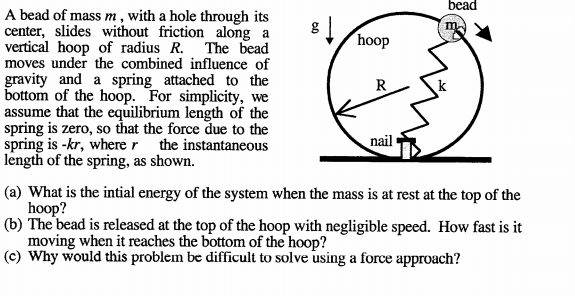A bead of mass m , with a hole through its center, slides without friction along a vertical hoop of radius R. moves under the combined influence of gravity and a spring attached to the bottom of the hoop. For simplicity, we assume that the equilibrium length of the spring is zero, so that the force due to the spring is -kr, where r the instantaneous length of the spring, as shown. The bead hoop R nail (a) What is the intial energy of the system when the mass is at rest at the top of the hoop? (b) The bead is released at the top of the hoop with negligible speed. How fast is it moving when it reaches the bottom of the hoop? (c) Why would this problem be difficult to solve using a force approach?
A bead of mass m , with a hole through its center, slides without friction along a vertical hoop of radius R. moves under the combined influence of gravity and a spring attached to the bottom of the hoop. For simplicity, we assume that the equilibrium length of the spring is zero, so that the force due to the spring is -kr, where r the instantaneous length of the spring, as shown. The bead hoop R nail (a) What is the intial energy of the system when the mass is at rest at the top of the hoop? (b) The bead is released at the top of the hoop with negligible speed. How fast is it moving when it reaches the bottom of the hoop? (c) Why would this problem be difficult to solve using a force approach?
Related questions
Question

Transcribed Image Text:bead
A bead of mass m , with a hole through its
center, slides without friction along a
vertical hoop of radius R.
moves under the combined influence of
gravity and a spring attached to the
bottom of the hoop. For simplicity, we
assume that the equilibrium length of the
spring is zero, so that the force due to the
spring is -kr, where r the instantaneous
length of the spring, as shown.
The bead
hoop
R
nail
(a) What is the intial energy of the system when the mass is at rest at the top of the
hoop?
(b) The bead is released at the top of the hoop with negligible speed. How fast is it
moving when it reaches the bottom of the hoop?
(c) Why would this problem be difficult to solve using a force approach?
Expert Solution
This question has been solved!
Explore an expertly crafted, step-by-step solution for a thorough understanding of key concepts.
This is a popular solution!
Trending now
This is a popular solution!
Step by step
Solved in 4 steps with 1 images
